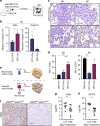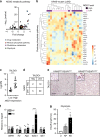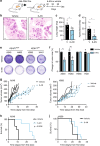Distinct initiating events underpin the immune and metabolic heterogeneity of KRAS-mutant lung adenocarcinoma
- PMID: 31519898
- PMCID: PMC6744438
- DOI: 10.1038/s41467-019-12164-y
Distinct initiating events underpin the immune and metabolic heterogeneity of KRAS-mutant lung adenocarcinoma
Abstract
The KRAS oncoprotein, a critical driver in 33% of lung adenocarcinoma (LUAD), has remained an elusive clinical target due to its perceived undruggable nature. The identification of dependencies borne through common co-occurring mutations are sought to more effectively target KRAS-mutant lung cancer. Approximately 20% of KRAS-mutant LUAD carry loss-of-function mutations in KEAP1, a negative regulator of the antioxidant response transcription factor NFE2L2/NRF2. We demonstrate that Keap1-deficient KrasG12D lung tumors arise from a bronchiolar cell-of-origin, lacking pro-tumorigenic macrophages observed in tumors originating from alveolar cells. Keap1 loss activates the pentose phosphate pathway, inhibition of which, using 6-AN, abrogated tumor growth. These studies highlight alternative therapeutic approaches to specifically target this unique subset of KRAS-mutant LUAD cancers.
Conflict of interest statement
The authors declare no competing interests.
Figures







Similar articles
-
LKB1 and KEAP1/NRF2 Pathways Cooperatively Promote Metabolic Reprogramming with Enhanced Glutamine Dependence in KRAS-Mutant Lung Adenocarcinoma.Cancer Res. 2019 Jul 1;79(13):3251-3267. doi: 10.1158/0008-5472.CAN-18-3527. Epub 2019 Apr 30. Cancer Res. 2019. PMID: 31040157 Free PMC article.
-
Mild Oxidative Stress Reduces NRF2 SUMOylation to Promote Kras/Lkb1/Keap1 Mutant Lung Adenocarcinoma Cell Migration and Invasion.Oxid Med Cell Longev. 2020 Nov 24;2020:6240125. doi: 10.1155/2020/6240125. eCollection 2020. Oxid Med Cell Longev. 2020. PMID: 33299528 Free PMC article.
-
Mutations in the KEAP1-NFE2L2 Pathway Define a Molecular Subset of Rapidly Progressing Lung Adenocarcinoma.J Thorac Oncol. 2019 Nov;14(11):1924-1934. doi: 10.1016/j.jtho.2019.07.003. Epub 2019 Jul 16. J Thorac Oncol. 2019. PMID: 31323387
-
Biological insights in non-small cell lung cancer.Cancer Biol Med. 2023 Jun 28;20(7):500-18. doi: 10.20892/j.issn.2095-3941.2023.0108. Cancer Biol Med. 2023. PMID: 37381723 Free PMC article. Review.
-
Clinical Implications of KEAP1-NFE2L2 Mutations in NSCLC.J Thorac Oncol. 2021 Mar;16(3):395-403. doi: 10.1016/j.jtho.2020.11.015. Epub 2020 Dec 8. J Thorac Oncol. 2021. PMID: 33307193 Review.
Cited by
-
Recent findings in the regulation of G6PD and its role in diseases.Front Pharmacol. 2022 Aug 24;13:932154. doi: 10.3389/fphar.2022.932154. eCollection 2022. Front Pharmacol. 2022. PMID: 36091812 Free PMC article. Review.
-
Glutamine antagonist DRP-104 suppresses tumor growth and enhances response to checkpoint blockade in KEAP1 mutant lung cancer.Sci Adv. 2024 Mar 29;10(13):eadm9859. doi: 10.1126/sciadv.adm9859. Epub 2024 Mar 27. Sci Adv. 2024. PMID: 38536921 Free PMC article.
-
Cellular Origins of EGFR-Driven Lung Cancer Cells Determine Sensitivity to Therapy.Adv Sci (Weinh). 2021 Nov;8(22):e2101999. doi: 10.1002/advs.202101999. Epub 2021 Oct 7. Adv Sci (Weinh). 2021. PMID: 34622577 Free PMC article.
-
Inhibition of Heat Shock-Induced H3K9ac Reduction Sensitizes Cancer Cells to Hyperthermia.Int J Biol Sci. 2023 Sep 11;19(15):4849-4864. doi: 10.7150/ijbs.86384. eCollection 2023. Int J Biol Sci. 2023. PMID: 37781518 Free PMC article.
-
Preclinical Models for the Study of Lung Cancer Pathogenesis and Therapy Development.Cold Spring Harb Perspect Med. 2021 Dec 1;11(12):a037820. doi: 10.1101/cshperspect.a037820. Cold Spring Harb Perspect Med. 2021. PMID: 34518338 Free PMC article. Review.
References
Publication types
MeSH terms
Substances
LinkOut - more resources
Full Text Sources
Medical
Miscellaneous

